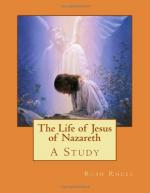32. SandayHastBD II. 612f.; GilbertLJ 144-157; WeissLX I. 355-387; AndLOL 155-165; EdersLJM I. 336-363; BeysLJ II. 129-148 (assigns here a considerable part of the synoptic account of work in Capernaum).
33. The early confessions. On the genuineness of the Baptist’s testimony to “the Lamb of God” see M. Dods in Expos. Gk. Test. I .695f.; Westcott, Comm. on John, 20; EdersLJM 1. 342 ff.; WeissLX 1. 362f. (thinks the evangelist added “who taketh away the sin of the world"); Holtzmann, Hand-comm. IV. 38f. holds that the evangelist has put in the mouth of the Baptist a conception which was first current after the death of Jesus. On the confessions of Nathanael and the others, see Jour. Bib. Lit. 1898, 21-30.
34. Cana is probably the modern Khirbet Kana, eight miles N of Nazareth. A rival site is Kefr Kenna, three and one-half miles NE from Nazareth. See EnBib and HastBD, also AndLOL 162-164.
35. The miracles of Jesus are challenged by modern thought. It is customary in reading other documents than the N.T. instantly to relegate the miraculous to the domain of legend. Miracles, however, are integral parts of the story of Jesus’ life, and those who attempt to write that life eliminating the supernatural are constrained to recognize that he had marvellous power as an exorcist and healer of some forms of nervous disease. So E. A. Abbott, The Spirit on the Waters, 169-201. Our knowledge of nature does not warrant a dogmatic definition of the limits of the possible; see James, The Will to Believe, vii.-xiii., 299-327. The question is confessedly one of adequate evidence. The evidence for the supreme miracle—the transcendent character of Jesus—is clear, see Part III. chap. iv.; and the miraculous element in the story of his life must be considered in view of this supreme miracle. In association with him his miracles gain in credibility. In estimating the evidence for them their dignity and worthiness is important. What the devout imagination would do in embellishing the story of Jesus is exhibited in the apocryphal gospels; the miracles of the canonical gospels are of an entirely different type, which commends them as authentic. By definition a miracle is an event not explicable in terms of ordinary human experience. It is therefore futile to attempt to picture the miracles of Jesus in their occurrence, for the imagination has no material except that furnished by ordinary experience. For our day the miracles are of importance chiefly for the exhibition they give of the character of Jesus; they can be studied with this in view without regard to the curious question how they happened. Read SandayHastBD II. 624-628; and see Fisher, Grounds of Christian and Theistic Belief, chaps, iv.—vi., Supernatural Origin of Christianity^3, chap, xi.; Bruce, Miraculous Element in the Gospels; Apologetics, 409 ff.; Illingworth, Divine Immanence; Rainy, Orr, and Dods, The Supernatural in Christianity.




